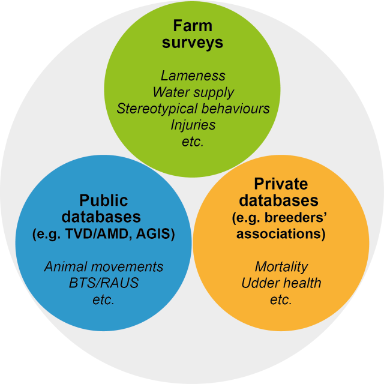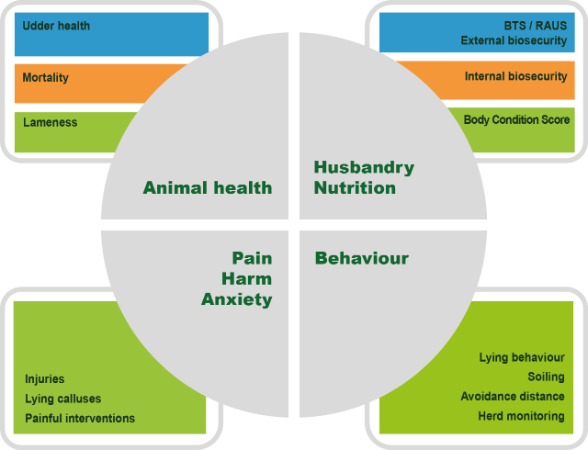The Smart Animal Health (SAH) project collects and links existing data on farm animals. Supplemented by targeted on-farm surveys, SAH makes it easier to identify correlations between husbandry and health. The current focus is on pig and dairy farms due to the abundance of data in these sectors.
As part of the SAH project, researchers are developing a methodology for the efficient, reliable collection and evaluation of data on animal health and welfare. Existing data from public and private sources is analysed, linked and checked for its information value. In an additional step, animal health indicators such as lameness, lesions and soiling are recorded during farm visits and assessed in terms of the necessary data collection effort.

By linking existing data and combining with animal health indicators recorded during farm visits, the researchers are producing a complete picture of livestock farming in Switzerland. Animal health and welfare can be described and assessed at the level of individual farms, groups of farms (e.g. use categories for pigs) and the Swiss livestock population as a whole. This will allow farms with healthy husbandry practices to be recognised and promoted while at the same time providing early advice and support to farms that need to optimise their procedures.
The objectives and methodology of the Smart Animal Health project are explained by Dr Katharina Stärk (Head of Knowledge Foundations, FSVO) and Beat Thomann (Vetsuisse Faculty, University of Bern). (in German)
Existing data sources as a basis for evaluating animal health and welfare
The TVD/AMD animal movements database, aRes laboratory data information system, FLEKO meat inspection database, AGIS agricultural policy information system and other public sources provide valuable data that can serve as a basis for evaluating animal health and welfare. The availability of data from private databases is restricted and access is possible only with the consent of the relevant animal keepers and data owners. In a future stage, existing data sources will be optimised and additional sources integrated, such as the IS-ABV database on antibiotic consumption.

No information on behaviour, injuries and pain
The surveys to date show major differences in terms of data availability and quality between the various livestock species. Valuable data is stored largely in private databases and available only to a limited extent. There is virtually no data on indicators in the sub-areas “behaviour” and “pain, injuries and anxiety”. This data currently has to be collected directly from the animal on the farm at considerable expense. However, combined with existing data from public and private sources, it is vitally important if the researchers’ assessment of animal health and welfare is to yield reliable information.
Gabriele Schachermayr (vice-director FOAG) and Thomas Echtermann (Vetsuisse Faculty, University of Zurich) report on the project and the selected data (in German).
Focus on pig and dairy farms
Data from pig and dairy farms proved relatively abundant in the first phase of SAH. The current phase therefore aims to determine the optimal linking of this data and its information value. Qualified specialists are assessing on-farm indicators recorded during farm surveys with the aim of identifying potentially valuable health indicators that can be collected with little effort (“iceberg indicators”). To clarify the practical implementation and acceptance of the SAH methodology and its integration into existing animal health recording systems, stakeholder participation is actively sought and encouraged.
Long-term goals
Implementing the methodology developed in the project should allow the researchers to use existing data and a small number of health indicators that can be collected on-farm with little additional effort:
- to observe and compare the animal health status at farm and population level and identify changes over time;
- to assess and if necessary optimise the effectiveness of measures to improve animal health.
Smart Animal Health – a joint project
The “Smart Animal Health” research project was launched in 2018 by the FSVO in cooperation with the Federal Office for Agriculture (FOAG). Results on the usefulness and information value of existing data from public and private sources and on health indicators that can be easily recorded on-farm are expected by the end of 2024.
More information
In detail
Overview of commercially available digital systems in livestock farming (in German) (PDF, 3 MB, 15.07.2020)This report gives an overview of digital systems currently available on the international market for the early detection of welfare and health problems in farm animals.
Last modification 18.01.2024




